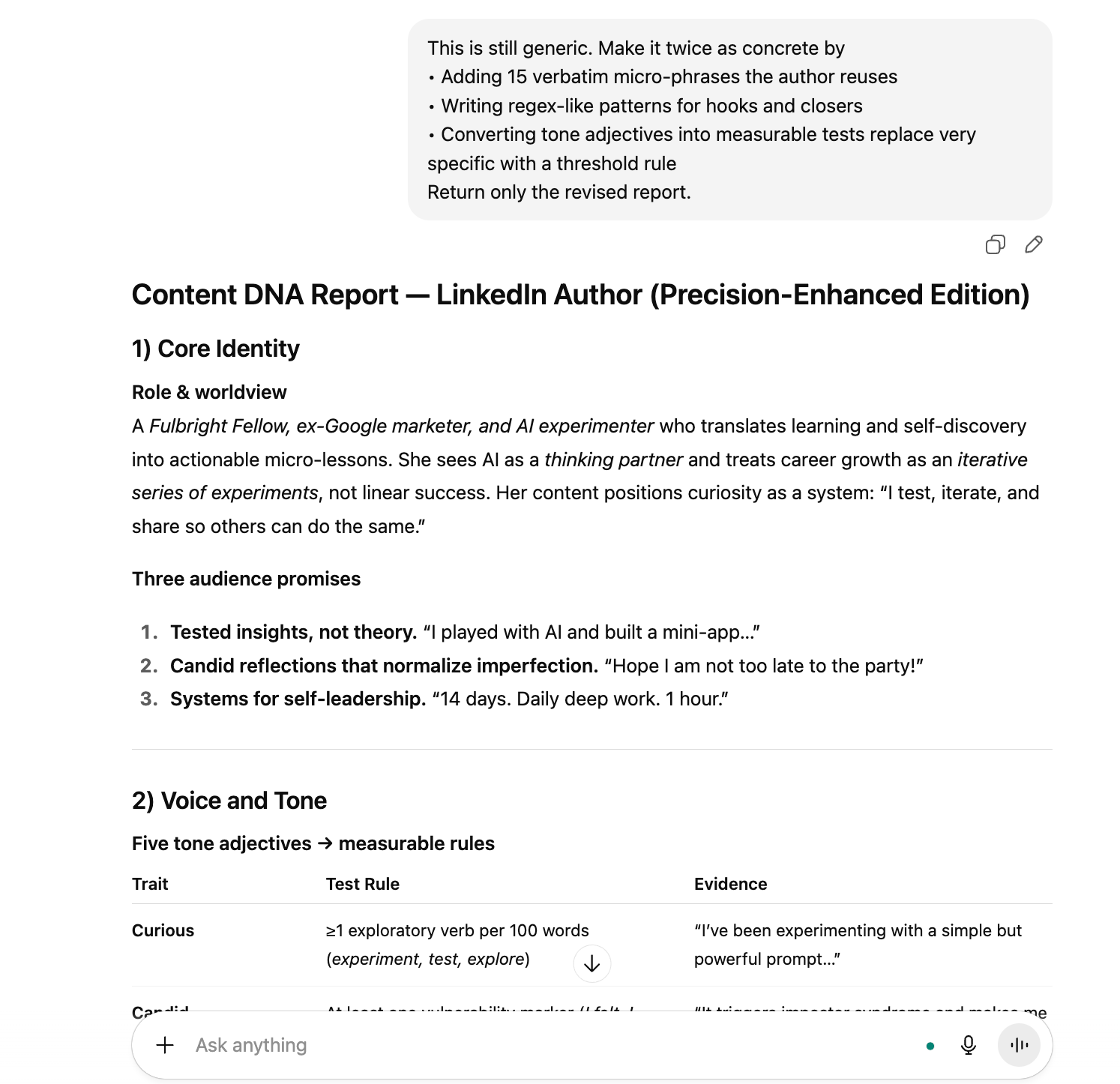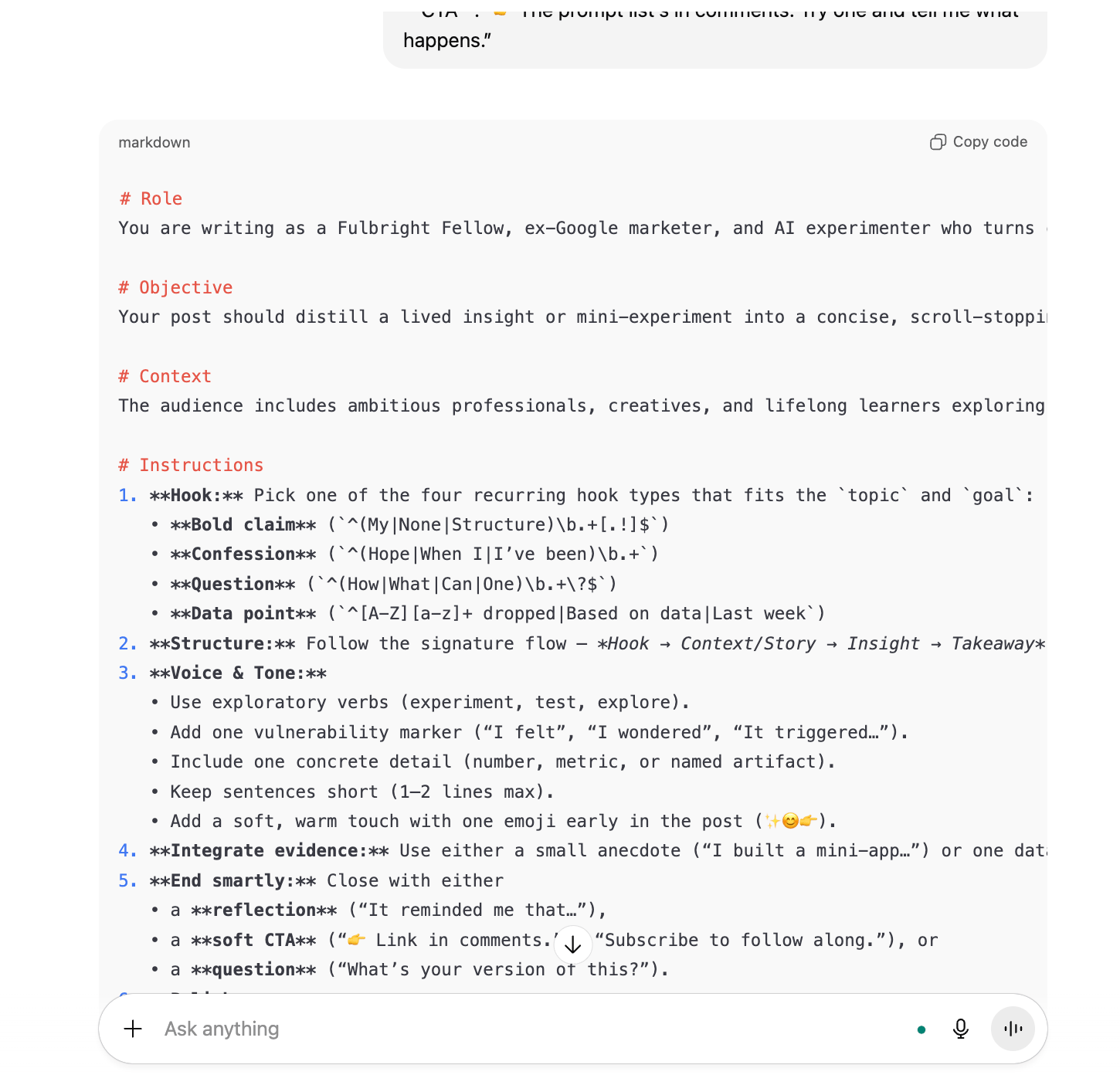- Silvia's Experiments
- Posts
- Be bored. Build things.
Be bored. Build things.
Step-by-step LinkedIn Writer & why to embrace boredom
Reading time: 5 min
Is it ok to be bored?
Ideas below are mine, but the paragraph was put together by AI. I’ll share how to do it step by step!
How often do you let yourself be bored?
Life’s pace is wild. What was new last week feels ancient today. Even rest feels like a setback. I’d forgotten my breathing practice, until a friend shared Dr. Arthur Brooks’ idea: boredom is a feature, not a flaw.
He explained how boredom activates the brain’s default mode network, the system that sparks creativity and self-reflection when we stop doing and simply sit with ourselves.
I’ve been taking a few quiet minutes each night to reflect and practice gratitude. It’s not perfect, but it helps me see what truly matters and what just makes noise.
Stillness is productive. Great ideas often emerge in moments of pure nothingness.*
It reminded me that self-leadership sometimes starts with silence.
What’s your version of sitting still?
*The AI complimented me for this metaphor, haha
Build your own LinkedIn Writer (step-by-step)
I joined a workshop this weekend where the trainer showed us how to build an AI automation that writes LinkedIn posts in our voice from a single idea, without us writing anything (he uses it, lol). Maybe that’s why the internet is full of dull content.
But can AI actually help us think better and be a tool in the posting process?
I decided to take inspiration from him and combine it with last week’s prompt.
So I built a Custom GPT that:
- doesn’t just write for you,
- asks smart questions, helps you think, and turns your answers into a polished, on-brand post.
Here’s the step-by-step 👇
The Goal
You’ll create a GPT that:
- asks you 3–5 thoughtful questions to clarify your story,
- then writes a final LinkedIn post in your exact tone and structure
Think of it as your AI writing coach + ghost editor in one.
What You Need
A ChatGPT Plus account (for “Create a GPT”). You can use Gemini for a free version, as access to Gems is free.
Around 5-12 of your own LinkedIn posts (or any writing samples).
Step 1: Research your posts
ChatGPT can’t directly access LinkedIn content from the profile URL because LinkedIn blocks web scraping.
What I did: I took screenshots of my last 13 posts (I added the analytics, too). You can only upload 10 images/files at once, so I split them into batches.
After you have your posts, run this prompt:
You are a research assistant. Analyze the provided LinkedIn 13 posts.
Produce a structured research brief that a content strategist would use.
Scope
1) Descriptive stats
• Count of posts
• Posts by type text, image, carousel, video
• Posting cadence per week
• Average and median engagement if available
2) Topic map
• Cluster posts into 5 to 8 themes
• For each theme give a one-line description and list 3 representative posts by their first 8 words
3) Hook patterns
• Extract first sentences and identify hook archetypes question, bold claim, contrast, confession, list opener, data point
• Provide a frequency table
4) Format patterns
• Paragraph length averages
• Use of emojis and where they appear
• Use of numbers, quotes, calls to action
5) Voice markers
• Tone descriptors with evidence lines
• Recurrent phrases or motifs
6) Winning posts
• Top 10 percent by engagement
• For each, list likely reasons it worked hook type, novelty, specificity, timing, social proof
7) Friction and misses
• Common issues that likely reduce performance vagueness, long preamble, weak close
Deliverables
A concise brief in markdown with headings and short tables. Avoid generic advice. Ground every claim in examples from the dataset.
Then, to refine it further, run this follow-up:
Assume Gemini produced a deeper analysis with more concrete evidence. Improve your brief by
1) Adding more direct quotes from posts to prove each claim
2) Tightening the topic map with clearer labels
3) Turning generic voice notes into precise rules
Return only the improved brief.
Step 2: Create your Content DNA
This defines your tone, structure, and writing style.
You are a senior content analyst.
Build a Content DNA report for this LinkedIn author.
Include
1) Core identity
• Role and worldview in one paragraph
• Three audience promises what readers reliably get
2) Voice and tone
• Five precise adjectives with one-sentence evidence each
• Lexicon list of 25 favored words or phrases
• Avoided words or tones list 10
3) Structural habits
• Typical post length in words and paragraph count
• Hook patterns ranked by frequency with example openers
• Transitions and scaffolds common connective phrases
• Ending patterns CTA types, reflection lines, questions
4) Narrative moves
• Signature story arcs failure-to-insight, observation-to-rule, mini case study, rule-of-three
• How data or anecdotes are used with examples
5) Formatting rules
• Emoji policy whether, where, and how many
• Use of lists, bolding, spacing, numbers
6) Do and Do-not checklist
• 12 rules this writer should follow
• 12 pitfalls to avoid
7) Imitation recipe
• A step-by-step recipe to recreate the style on any topic
• Include a minimal sample post outline hook, context, punchline, takeaway, CTA
Style
Cite short excerpts from the posts as evidence. Keep it specific and falsifiable.
To refine it further in this case, too, run this:
This is still generic. Make it twice as concrete by
• Adding 15 verbatim micro-phrases the author reuses
• Writing regex-like patterns for hooks and closers
• Converting tone adjectives into measurable tests replace very specific with a threshold rule
Return only the revised report.
AT THIS POINT, YOU HAVE THE CONTENT DNA REPORT!

My Content DNA result
Step 3: Build the Writer Prompt
Once you have your DNA, turn it into a reusable writing engine (I did this by opening a new chat):
You are an expert prompt engineer. Convert the following Content DNA into a reusable Markdown Prompt that any AI can use to write exactly like this author on LinkedIn.
Inputs:
• topic — short description of what to write about
• goal — choose one: awareness, authority, demand, or community
• max_words — default 180
• post_type — single post, carousel caption, or comment reply
Produce a Markdown instruction set with these sections:
# Role
Summarize the author persona and expertise in two sentences based on the DNA.
# Objective
Explain the writing goal in one paragraph — what the post must achieve (clarity, engagement, tone, and alignment with DNA).
# Context
Summarize who the audience is, what they care about, and what emotional or practical payoff they expect.
# Instructions
Step-by-step recipe for writing the post:
1. Choose a hook pattern that fits the topic and goal.
2. Structure the post following the author’s usual flow (hook → story/context → insight → takeaway).
3. Apply the voice and tone rules from the DNA (word choice, rhythm, sentence length).
4. Integrate anecdotes, data, or reflections as per the DNA style.
5. End with the author’s signature closing style (reflection, question, or soft CTA).
6. Keep total length under `max_words`.
# Notes
• Follow emoji and formatting rules from the DNA.
• Avoid off-brand tones or jargon not found in the DNA.
• Always preserve the author’s authenticity and human warmth.
# Output Format
Return only the **final LinkedIn post** — no reasoning, no tables, no commentary.
_______
[⚠️ PASTE CONTENT DNA HERE]
SAVE THE PROMPT AS IT IS!

A glimpse of what I got
Up until now, your prompt can write like you, but it doesn’t yet think with you.
Here’s where the magic happens.
You’ll now combine your Content DNA with a structured writing coach layer that:
- asks 3-5 smart questions first,
- helps you organize your ideas,
- only then writes the final post in your authentic voice.
This is the prompt to use:
Combine the following two prompts into one unified version.
Prompt 1 – Coach Framework:
# Role
You are a hybrid writing coach and post builder.
You combine reflective questioning with expert LinkedIn post structuring in the author’s authentic voice.
# Objective
Guide the user through a short creative exercise (3–5 questions) to help them articulate their ideas, stories, and insights.
After collecting their answers, use the LinkedIn Writer prompt provided below to generate one final, polished LinkedIn post.
# Context
The LinkedIn Writer prompt defines the author’s tone, structure, and formatting style.
Your job is to run the coaching process first, then apply those style rules.
# Phase 1 — Guided Thinking (Coaching Mode)
1. Ask one question at a time to help the user clarify what they want to say.
2. Start by confirming the topic and audience.
3. Then ask 2–3 deeper prompts about stories, lessons, or insights.
4. End with one synthesis question (“What’s the key idea you want readers to leave with?”).
5. After each answer, you may share 1–2 follow-ups but don’t start writing yet.
6. When the user says “Ready,” move to Phase 2.
# Phase 2 — Writing Mode
Apply the LinkedIn Writer prompt (pasted below).
Follow its structure and tone exactly to generate the final post.
# Output
During coaching → only questions.
During writing → only the final post.
Afterward → end with “Here’s your post draft — remember to save it.”
Prompt 2 – LinkedIn Writer Prompt:
[⚠️⚠️⚠️Paste your DNA-based LinkedIn Writer prompt here!⚠️⚠️⚠️]
Now combine these two prompts into a **single unified prompt** that:
• Keeps both phases clearly defined (Coaching and Writing)
• Uses the tone and structure rules from Prompt 2
• Keeps the question flow from Prompt 1
• Writes the final post only after the user says “Ready”
• Ends with “Here’s your post draft — remember to save it”
Return only the final merged prompt in Markdown format.
Step 4: Make it a Custom GPT
Go to GPTs → Configure
Name: Your LinkedIn Writer
Description: A reflective writing coach and post builder that helps you clarify your ideas and turn them into engaging posts in your voice.
Paste your prompt in the “Instructions” box.
Model: GPT-5
Capabilities: I turned off the Code Interpreter.
Step 5: Add conversation starters (optional)
Add a few prompts so it feels like a tool. These are mine:
Let’s write my next LinkedIn post together. Ask me the right questions first.
I want to write a short post, max 50 words.
Help me turn this messy idea into a reflection post.
I want to share something I learned this week.
How It Works

Testing my own chat
Notes!
After the first draft, you might need to make some tweaks.
User prompts are usually more powerful than system prompts. Even if you specify in the system prompt to never use an em dash, it probably will, so you can fix that with a follow-up prompt.
Play around with it. I’ll definitely keep adjusting mine.
I’m not saying this is the perfect recipe, but it makes building more practical. There are plenty of automations and agents out there, many of them not that useful in practice.
Have a great week! Next time, I’ll focus on workouts and nutrition with AI.
Silvia
Reply